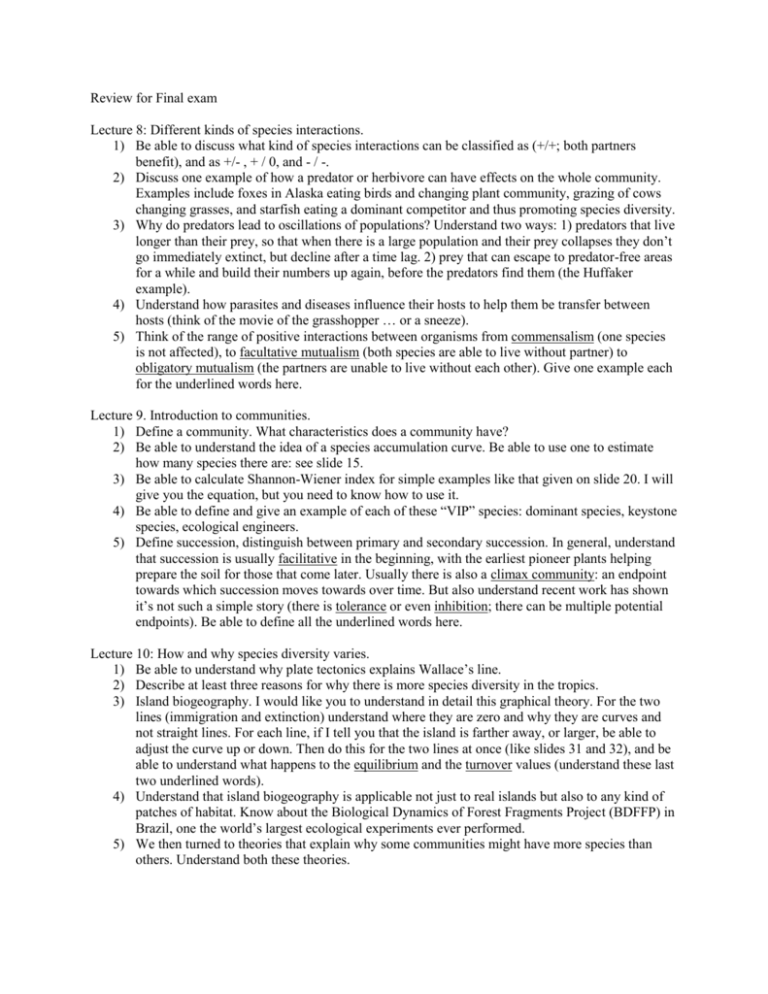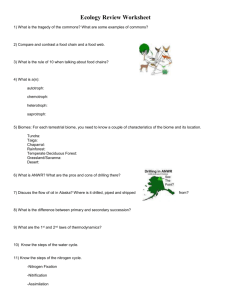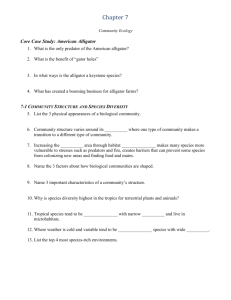review_for_final_exam5.14
advertisement

Review for Final exam Lecture 8: Different kinds of species interactions. 1) Be able to discuss what kind of species interactions can be classified as (+/+; both partners benefit), and as +/- , + / 0, and - / -. 2) Discuss one example of how a predator or herbivore can have effects on the whole community. Examples include foxes in Alaska eating birds and changing plant community, grazing of cows changing grasses, and starfish eating a dominant competitor and thus promoting species diversity. 3) Why do predators lead to oscillations of populations? Understand two ways: 1) predators that live longer than their prey, so that when there is a large population and their prey collapses they don’t go immediately extinct, but decline after a time lag. 2) prey that can escape to predator-free areas for a while and build their numbers up again, before the predators find them (the Huffaker example). 4) Understand how parasites and diseases influence their hosts to help them be transfer between hosts (think of the movie of the grasshopper … or a sneeze). 5) Think of the range of positive interactions between organisms from commensalism (one species is not affected), to facultative mutualism (both species are able to live without partner) to obligatory mutualism (the partners are unable to live without each other). Give one example each for the underlined words here. Lecture 9. Introduction to communities. 1) Define a community. What characteristics does a community have? 2) Be able to understand the idea of a species accumulation curve. Be able to use one to estimate how many species there are: see slide 15. 3) Be able to calculate Shannon-Wiener index for simple examples like that given on slide 20. I will give you the equation, but you need to know how to use it. 4) Be able to define and give an example of each of these “VIP” species: dominant species, keystone species, ecological engineers. 5) Define succession, distinguish between primary and secondary succession. In general, understand that succession is usually facilitative in the beginning, with the earliest pioneer plants helping prepare the soil for those that come later. Usually there is also a climax community: an endpoint towards which succession moves towards over time. But also understand recent work has shown it’s not such a simple story (there is tolerance or even inhibition; there can be multiple potential endpoints). Be able to define all the underlined words here. Lecture 10: How and why species diversity varies. 1) Be able to understand why plate tectonics explains Wallace’s line. 2) Describe at least three reasons for why there is more species diversity in the tropics. 3) Island biogeography. I would like you to understand in detail this graphical theory. For the two lines (immigration and extinction) understand where they are zero and why they are curves and not straight lines. For each line, if I tell you that the island is farther away, or larger, be able to adjust the curve up or down. Then do this for the two lines at once (like slides 31 and 32), and be able to understand what happens to the equilibrium and the turnover values (understand these last two underlined words). 4) Understand that island biogeography is applicable not just to real islands but also to any kind of patches of habitat. Know about the Biological Dynamics of Forest Fragments Project (BDFFP) in Brazil, one the world’s largest ecological experiments ever performed. 5) We then turned to theories that explain why some communities might have more species than others. Understand both these theories. a. Heterogeneous environment theory: Environments that are variable have room for more niches, and hence more species. Example: rainforest has vegetation with a variety of heights. b. Intermediate disturbance theory: Environments that are not too stable (dominant competitors outcompete all species) or too disturbed (harsh conditions don’t allow many species to live) will have most diversity. 6) Lastly we looked at some evidence that if there are higher species the overall community is more stable or resilient to a disturbance. Experimental plots with more species had higher biomass one year after a drought (slide 56). Lecture 11. Introduction to ecosystems. 1) Define an ecosystem and know what characteristics it has. 2) Contrast Gross Primary Production to Net Primary Production (NPP). How is NPP estimated? 3) Know the major limiting factors for NPP in terrestrial and aquatic ecosystems. 4) Know what happens during the process of eutrophication. 5) Be able to explain why there are fewer species and individuals at the top of the food web than at the bottom. When discussing the efficiency of energy transfer, think about the different processes where energy is lost. For example, transferring energy from plants to insects (slides 32 and 33): some plants are not eaten; of those that are some energy is excreted, more is metabolized, and only a little bit is put into biomass and growth. 6) Understand why some toxins accumulate at the tops of food webs (they can’t be excreted or metabolized), and know some examples of dangerous substances that do this. Lecture 12. Nutrient cycling and environmental crises. 1) Define and understand the following words: nutrient, weathering, leaching. 2) Nutrients cycle between different pools (atmosphere, vegetation, soil, rocks, freshwater, marine waters), with the amount of time they spend in any one pool measured by the “residence time”. 3) Know the cycles for C, N, and P (slides 16, 18, 20). Compare and contract: which nutrients have large pools in the atmosphere? Which have large pools in sediments under the ocean? Which of these nutrient cycles is most affected by human disturbance? 4) For the environmental problems we talked about: a. For habitat loss, contrast loss with fragmentation and degradation (they are three aspects of the same problem). This is a clear #1 in terms of problems. Understand how it is caused both by human population, and rising consumption per person. b. For species invasions, remember how earlier we talked about situations in which a species was introduced to a new area without its predator and became very abundant before the predator was introduced as a way of “bio-control”. This is one reason why invasives can be dangerous. c. For over-harvesting, global climate change, nitrogen deposition and toxins know the basics of the problems. What side-effects of global climate change are there (melting ice, rising sea levels, ocean acidification)? d. Know the history of the ozone layer problem, as it’s a good example of a problem that has been addressed, and shows that these kinds of problems can be fixable. Lecture 13. Conservation Biology and Landscape Ecology. 1) From the end of the last lecture (lecture 12, starting slide 55) and the beginning of this lecture, know some reasons why we should conserve biodiversity. We concentrated on economic reasons; be able to discuss several ways in which biodiversity is valuable in terms of money. 2) What problems do small populations face? We have looked at these in classes before. Be able to describe how these problems lead to a downward spiral (“extinction vortex”) for small populations. 3) In this lecture we talk about 4 different approaches conservation biologists take to protecting biodiversity: 1) improving the genetics of small populations, 2) making management plans for species declining in the wild, 3) breeding very rare species ex-situ, 4) designing parks and reserves that protect species. 4) We also talk about “priorities” (in a world with limited money and time, what should we concentrate on? We talked about prioritizing species (rare ones) and places (hotspots that are threatened and have many endemic species – those found only there). 5) About landscape ecology, understand the following vocabulary: extent, grain, patch, matrix, corridor. 6) Look at the figure about park design on the right hand side of slide 23. Be able to explain why the theory of island biogeography informs us how to best plan reserves in terms of reserve size, number of reserves, reserve proximity and reserve connectivity. A few big ideas that we’ve looked at repeatedly in class: 1) Natural selection is a big idea that I’d like you to master, as it really explains a lot about biology. Know the steps involved in natural selection (slide 10, lecture 4). 2) The idea of a trade-off – different strategies each have their advantages and disadvantages – was on the midterm and could be on this exam, too. There is no perfect strategy. 3) Look carefully at the “levels of organization” slide (see lecture 13, slide 28). Be able to understand what kind of ecological questions scientists study at each level. For example, what does a community ecologist study? What does a population ecologist study? What does an ecosystem ecologist study? Be able to define the different levels of organization and know the properties (“characteristics”) of each level. For example a community is described by the number of species, and species diversity. 4) How is ecology a science that has many applications to environmental problems? Our last two lectures mentioned many examples of ecologists working on human-caused environmental problems. The readings: Isack and Reyes 1989: What data do they show to establish that both sides (humans, honeyguides) benefit? What data do they show to establish that honeyguides communicate information about the hiveto humans? Terborgh et al. 2001 Why would you call this a natural experiment? Describe what happened at the site where the scientists worked before they started collecting data. What happened ecologically on islands without predators (big cats and ant-eating armadillos)? Jackson et al. 2001 What kind of scientists wrote this article? What do they study and what kind of data did they collect. What kind of marine habitats do they review? What’s their conclusion as to what has been the most important human activity that has harmed these ecosystems? Myers et al. 2000 How do the authors define a hotspot? Are there any in China and where? How do the authors want their hotspot list to be used?











